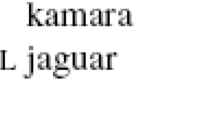Abstract
Investigating some word order phenomena in Chinese, we will arrive at the conclusion that Chinese has to be characterised as a VO language. The evidence is drawn mainly from the behaviour of locative PPs. Making extensive comparisons with the behaviour of locative PPs in Dutch, we show that in Chinese, all locative adjunct PPs appear on the left-hand side of the verb, whereas predicative complements follow the verb. Contrary to the communis opinio, we claim that this generalization holds unconditionally.
We briefly touch upon some consequences of this result for the theory of directionality. One of these consequences is that the OV/VO distinction can and should be cast in terms of a Theta Directionality parameter. Other parameters that have been proposed in the literature, especially Headedness, are irrelevant to accounting for the Chinese word-order facts.
Similar content being viewed by others
References
Abney, S. P.: 1986, The English Noun Phrase in Its Sentential Aspect, Ph.D. dissertation, MIT, Cambridge.
Beukema, F. and T. Hoekstra: 1984, ‘Extractions from with-Constructions’, Linguistic Inquiry 15, 689–98.
Bouman, J.: 1989, Deverbale Nomina, Light Verbs en Denominale Verba, MA Thesis, University of Leiden.
Chao, Y. R.: 1968, A Grammar of Spoken Chinese, University of California Press, Berkeley.
Culicover, P. W. and M. S. Rochemont: 1990, ‘Extraposition and the Complement Principle’, Linguistic Inquiry 21, 23–47.
Dowty, D.: 1979, Word Meaning and Montague Grammar, Reidel, Dordrecht.
Grimshaw, J. and A. Mester: 1988, ‘Light Verbs and Theta Marking’, Linguistic Inquiry 19, 205–32.
Hoekstra, T.: 1984, Transitivity, Foris Publications, Dordrecht.
Hoekstra, T.: 1988, ‘Small Clause Results’, Lingua 74, 101–39.
Hoekstra, T., M. Lansu and M. Westerduin: 1988, ‘Complexe Verba’, Glot 10, 61–79.
Hoekstra, T. and R. Mulder: 1990, ‘Unergatives as Copular Verbs: Locational and Existential Predication’, The Linguistic Review 7, 1–79.
Hoffman, M.: 1990, Movement, Traces and Incorporation in the Lexicon, Paper read at the Second Leiden Conference for Junior Linguists.
Huang, J. C. T.: 1982, Logical Relations in Chinese and the Theory of Grammar, Ph.D. dissertation, MIT, Cambridge.
Huang, J. C. T.: 1987, ‘Existential Sentences in Chinese and (In)definiteness’, in E. Reuland and A. ter Meulen (eds.), The Representation of (In)definiteness, MIT Press, Cambridge, MA, pp. 226–53.
Jackendoff, R. S.: 1974, ‘A Deep Structure Projection Rule’, Linquistic Inquiry 5, 481–505.
Kayne, R.: 1984, Connectedness and Binary Branching, Foris Publications, Dordrecht.
Kayne, R.: 1985, Principles of Particle Constructions, in J. Guéron, H.-G. Obenauer and J.-Y. Pollock (eds.), Grammatical Representation, Foris Publications, Dordrecht.
Koopman, H.: 1984, The Syntax of Verbs, Foris Publications, Dordrecht.
Koster, J.: 1975, ‘Dutch as an SOV Language’, Linguistic Analysis 1, 111–36.
Kuroda, S.-Y.: 1988, ‘Whether We Agree or Not’, Linguisticae Investigationes 12, 1–47.
Li, Y.-H. Audrey: 1985, Abstract Case in Chinese, Ph.D. dissertation, USC.
Li, Y.-H. Audrey: 1990, Order and Constiuency in Mandarin Chinese, Kluwer, Dordrecht.
Li, C. and S. Thompson: 1974, ‘An Explanation of Word Order Change SVO → SOV’, Foundations of Language 12, 201–14.
Li, C. and S. Thompson: 1975, ‘The Semantic Function of Word Order: A Case Study in Mandarin’, in C. Li (ed.), Word Order and Word Order Change, University of Texas Press, Austin, pp. 165–95.
Li, C. and S. Thompson: 1981, Mandarin Chinese: A Functional Reference Grammar, University of California Press, Berkeley.
Light, T.: 1979, ‘Word Order and Word Order Change in Mandarin Chinese’, Journal of Chinese Linguistics 7, 149–80.
Ma, Xiwen: 1987, ‘Yu Dongjieshi Dongci Youguan de Mouxie Jushi’, Zhongguo Yuwen 1987, 424–41.
Mei, K.: 1980, ‘Is Modern Chinese Really an SOV Language?’, Cah. de Ling. Asie Orientale 7, 23–45.
Moro, A.: 1990, ‘There-raising: Principles Across Levels’, Paper read at GLOW 1990, Cambridge, UK.
Mulder R. and P. Wehrmann: 1989, ‘Locational Verbs as Unaccusatives’, Linguistics in the Netherlands 1989, pp. 111–22.
Mullie, J.: 1932, The Structural Principles of the Chinese Language, Vol. 1, The Bureau of Engraving and Printing, Peking.
Riemsdijk, H. van: 1978, A Case Study in Syntactic Markedness: The Binding Nature of Prepositional Phrases, Foris Publications, Dordrecht.
Simpson, J.: 1983, ‘Resultatives’, in B. Levin, M. Rappaport and A. Zaenen (eds.), Papers in Lexical Functional Grammar, reproduced by the Indiana University Linguistics Club, Bloomington.
Stowell, T.: 1981, Origins of Phrase Structure, Ph.D. dissertation, MIT.
Tai, J. H. Y.: 1973, ‘Chinese as a SOV Language’, in C. Corum et al. (eds.), Papers from the Ninth Regional Meeting of the Chicago Linguistic Society, pp. 659–71.
Tai, J. H. Y.: 1976, ‘On the Change from SVO to SOV in Chinese’, in S.B. Steever et al. (eds.), Papers from the Parasession on Diachronic Syntax, CLS, pp. 291–304.
Travis, L.: 1984, Parameters and Effects of Word Order Variation, Ph.D. dissertation, MIT.
Zhou, X. P.: 1989, ‘Is Chinese a Head-Final Language?’, in M. K. M. Chan and T. Ernst (eds.), Proceedings of the Third Ohio State University Conference on Chinese Linguistics 1988, reproduced by the Indiana University Linguistics Club, Bloomington.
Author information
Authors and Affiliations
Rights and permissions
About this article
Cite this article
Mulder, R., Sybesma, R. Chinese is a VO language. Nat Lang Linguist Theory 10, 439–476 (1992). https://doi.org/10.1007/BF00133370
Received:
Revised:
Published:
Issue Date:
DOI: https://doi.org/10.1007/BF00133370




